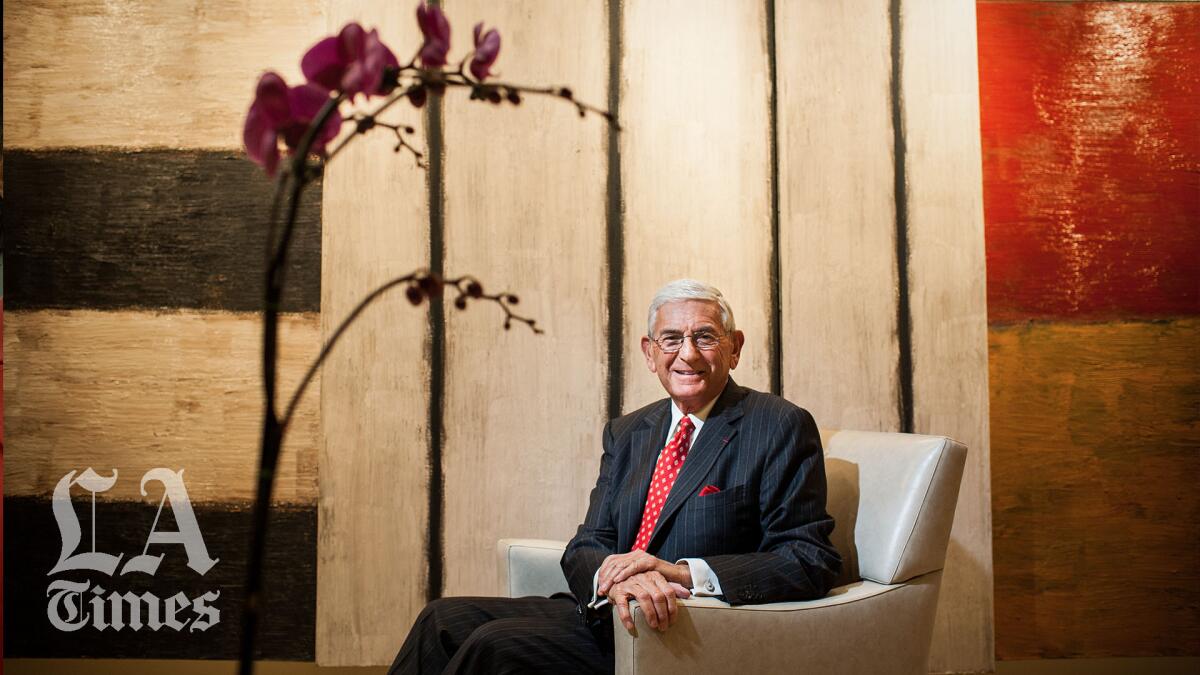Editorial: Eli Broad shaped arts, schools and downtown. L.A. needs more philanthropists like him

- Share via
Eli Broad was a stubborn man, sometimes irascible and often too controlling — but one of the relatively few people of great wealth to shower his philanthropic largesse on Los Angeles and California. There are many generous people in this area, but they tend to give to national and global causes. We could use more civically minded philanthropists like him.
Broad, who died Friday at the age of 87, spent millions upon millions on schools, museums, stem cell research centers. The problem was that he too often thought of the organizations to which he contributed as holdings in which he had purchased an interest.
He shocked the art world when, after finagling a showing of some of his extraordinary art collection at the Los Angeles County Museum of Art, and serving as vice chairman of the board, he then refused to do what had long been expected: leave his collection to the museum. Instead he created an eponymous museum where he knew the art would always be displayed rather than spending some of its time in storage. Yet he made a generous $30-million donation to the Museum of Contemporary Art and prevailed on other wealthy locals to do the same. The truth was, when a local arts institution was in trouble, Broad was one of the very first people to whom it appealed.
There were other times when Broad’s can-do attitude broke through walls and made things happen for the city, such as taking on the job of fundraising $135 million for Walt Disney Concert Hall, now one of the city’s arts icons, as the effort to build the center foundered. His contributions to UCLA, USC and UC San Francisco built stem cell centers that have become major research institutions in that field.
Though Broad made massive contributions to the arts, he has made the most, and most contentious, imprint over the last decade or so on education, particularly his interest in charter schools. His frustration with the failures of Los Angeles public schools to bring about some obviously needed changes resulted in major support for charter schools, which are publicly funded but privately managed. In good part because of his efforts, Los Angeles Unified has been a hot spot of charter school creation.
To the point that he provided financial support for good charter schools, his contribution made an enormous difference to thousands of students who craved something different from what their neighborhood school offered — schools with plenty of enrichment and high expectations. It’s a safe bet that many young people who went to college from those schools would not have been able to do so without the option.
But Broad took a simplistic and overly rosy view of what charter schools could accomplish. He conveniently overlooked the fact that charter schools for many years weren’t taking their fair share of students with special needs and that charter schools generally served a population of parents with the knowledge to seek out educational options. His foundation’s involvement in a plan to create enough charter schools so that half of all L.A. Unified students would attend them was poorly thought out and never took into account the devastating effect this would have on public schools and the many students who attend them.
He attempted to serve as a counterbalance to the influence that the teachers union, United Teachers Los Angeles, had on elections, donating heavily to benefit candidates who shared his vision. The result, between his contributions and those of like-minded benefactors, often meant that union-backed candidates were heavily outspent, and made school board races high-stakes competitions for positions that had long been thought of as nonpolitical.
He was a major donor in municipal political campaigns as well and was closely aligned with former mayors Richard Riordan, a Republican, and Antonio Villaraigosa, a Democrat. Broad was no silent donor; he used his money to influence policy, often to the consternation of labor and progressive groups.
And Broad used that same money and power to help shape downtown redevelopment. He was instrumental in completing the construction of the iconic Walt Disney Concert Hall. He later worked with civic leaders and developers to transform Grand Avenue into a “museum mile” with his Broad museum as the cornerstone. A $1-billion development of apartments, stores, restaurants, movie theaters is rising across from the Disney Hall and will mark the transformation of the area from moribund corridor to cultural destination.
Of course, long before he became a rich man with an estimated worth of $6.9 billion, Broad shaped the landscape in ways that have nothing to do with his philanthropy. He amassed his fortune through construction company KB Home, which built 600,000 houses in the country, many of those in Southern California. In doing so, he provided new homes for families, but he also contributed to suburban sprawl that has choked freeways and contributed to air pollution in the region.
But as much as he created a large share of the region’s suburban sprawl, Broad showed that much of his heart was in the urban center. He may have irked the heck out of people while giving, but give he did, and generously, to causes that will indeed shape the city — its arts, education and economy — for far longer than he lived on the planet. Criticize his specific visions or not, but he helped re-form Los Angeles from a city known mainly for Hollywood and traffic to one known for its thriving arts scene, its renewed efforts on its schools, its more vibrant downtown. And yes, for its traffic.
More to Read
A cure for the common opinion
Get thought-provoking perspectives with our weekly newsletter.
You may occasionally receive promotional content from the Los Angeles Times.










